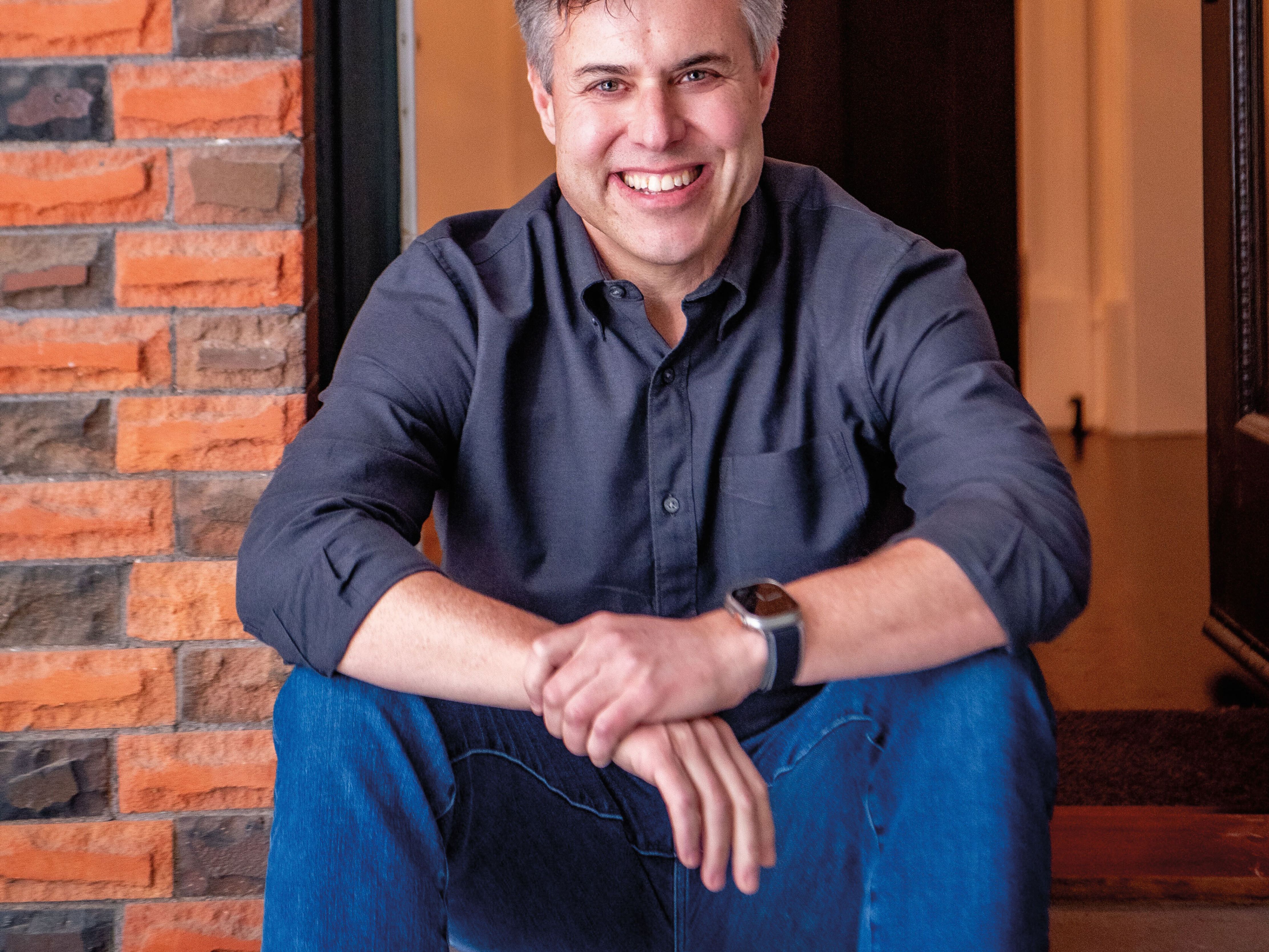The Seductive and Dangerous Terrain of East Vail
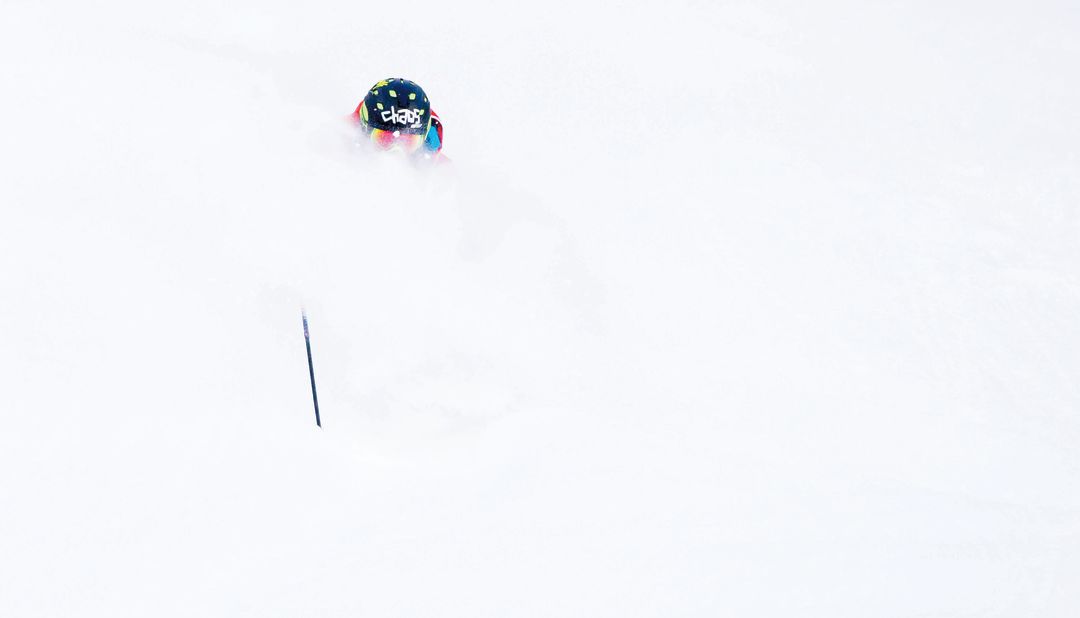
Image: Zach Mahone
Skiers and snowboarders flock to East Vail’s lift-accessible backcountry terrain in part because it’s unpatrolled and unregulated, but in the name of public safety, should—and can—anyone limit the risks people take on these avalanche-prone steeps?
In the eyes of those who organize their lives to float down deep powder on skis or a snowboard, there may be no backcountry zone in Colorado more seductive or infamous than the 3,000-vertical-foot expanse that towers above the bedroom community of East Vail. Thousands, probably tens of thousands, have felt the indescribable rush that East Vail delivers on a daily basis each winter. A much smaller number have had their lives tragically altered while chasing that rush.
Like all wilderness exploits, successful East Vail adventures are usually celebrated in private, while accidents attract the unwelcome—and often uninformed—glare of public scrutiny. This was never more apparent than during a 16-day stretch last winter, which, given the notoriety that comes with being the deadliest backcountry ski zone in the deadliest avalanche state in America, is saying something.
On December 22, 2013, three young men did what hundreds of other skiers and snowboarders do every day in Eagle County. They exited the boundary of their local ski resort and prepared to descend a run blanketed by pristine, wild snow. As Edwin LaMair stood atop the skier’s left flank of a steep, cliff-studded face known as Abraham’s—the most obvious run in East Vail when accessed from Vail Mountain—he felt confident in his preparation as well as the conditions. LaMair, then 22, had already skied Abraham’s once that day with his brother Davis, 19, and a friend. But a few inches of new snow had fallen between their first run and their second, so despite seeing roughly 10 tracks in the line, including their own, LaMair decided to stick to the trees this time. He would slash one turn on the open face, then spend the rest of his run carving powdery slalom turns around evergreens.
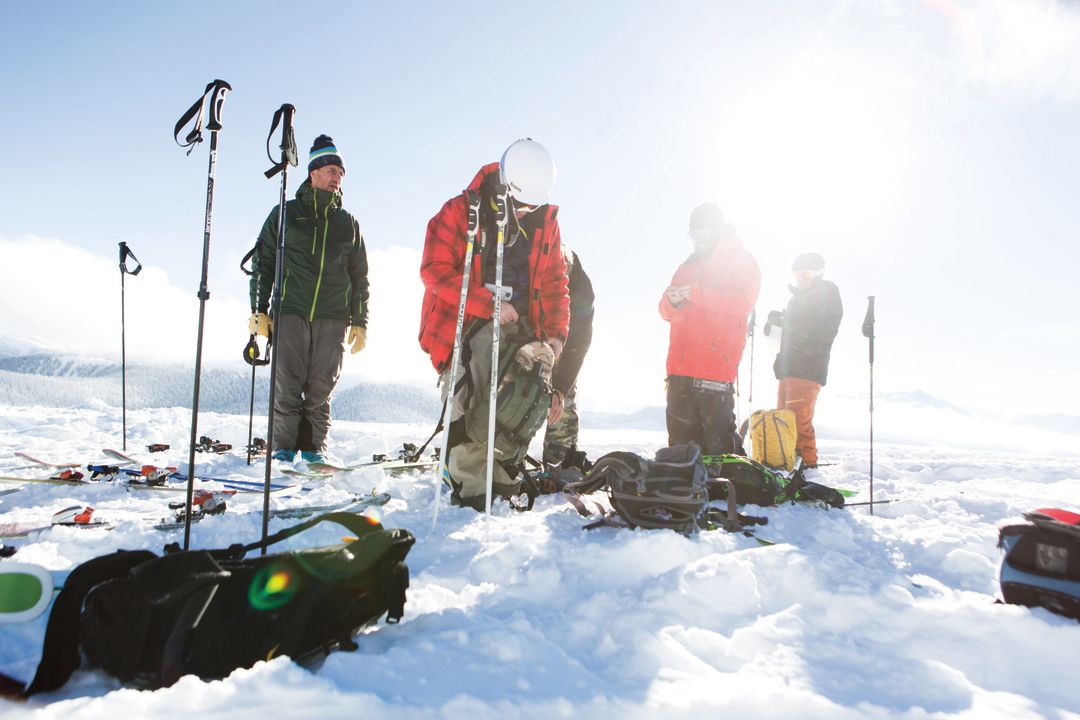
Image: Zach Mahone
One turn on the face was all it took to trigger the avalanche. LaMair was immediately swallowed by the snow, dragged over a cliff, and strained through trees like a pinball. If you are among the half-million people who viewed the YouTube clip of what happened next, you probably remember Davis LaMair landing a sizable cliff drop immediately after the avalanche, then skiing down to rescue his brother, who was buried with just his face and a hand above the debris. Local news stations aired Davis’s GoPro video, and Matt Lauer interviewed the brothers on the Today show. Overnight, Edwin LaMair went from being an anonymous Front Range college student whose family had skied Vail Mountain for decades to a national poster case for what can go wrong while backcountry skiing.
A little more than two weeks later, on January 7, 2014, another avalanche tore a hole in the community that may never heal. Vail Valley native Tony Seibert, whose grandfather, Pete Seibert Sr., had cofounded Vail Mountain 52 years prior, was among a group of four dropping through an avalanche path called Tweeners to ski a partially treed line just southeast of where LaMair’s slide occurred, known as NBA (Nothing But Air). An avalanche of astonishing proportions—three football fields wide and more than 10 feet deep at the crown—released above them, catching all four and sweeping Seibert to his death. He was 24.
National newspapers and television networks covered the story, thrusting East Vail and, as a result, Vail Mountain into the mainstream spotlight yet again. To locals, who have grown accustomed to hearing about accidents in chairlift-accessed backcountry zones, particularly East Vail, the shock was due less to what had happened than to who was involved. (In addition to Seibert, a big-mountain skier whose backcountry skills and knowledge were well known and respected, world champion freeskier Rebecca Selig was among the survivors.)
The back-to-back high-profile accidents returned a complicated dynamic to the fore and compelled locals and visitors alike to confront tough questions—about East Vail in particular, about resort-accessed backcountry skiing generally, and about their personal calculus for balancing risk vs. reward. Most salient among those questions: With user numbers exploding, what can be done to curb the peril and prevent backcountry adventurers—both enthusiasts and dabblers—from meeting a tragic fate of their own?
No one knows who skied East Vail first. But, as with many ski-related feats in Colorado, it was probably 10th Mountain Division soldiers, who trained at Camp Hale and often skied to Vail Pass, then over to East Vail and down the Mill Creek drainage to what is now the town of Vail. Pete Seibert Jr., who skied the zone for “area familiarization” while working for Vail Ski Patrol in the late 1970s, believes his father and fellow resort founder Earl Eaton skied there while assessing terrain in the ’60s. Shortly after Pete Seibert Sr. passed away in 2002, Eaton showed up at Pete Jr.’s office with a map of potential improvements to the resort, one of which depicted a tram running straight up the gut of East Vail. Pete Sr. even considered the zone as a possible World Cup downhill site before deciding on Birds of Prey at Beaver Creek.
It wasn’t until then-owner George Gillett Jr. expanded Vail’s terrain in the 1988–89 season to include China, Teacup, Siberia, and Mongolia bowls that East Vail suddenly became skiable with less than half a day’s time commitment. Skiers could now use lifts to ascend most of the 3,000 feet inbounds, then leave the resort and bang out a 15-minute uphill hike to Benchmark, the treeless crown of the zone. And because of widespread skier support of the Forest Service’s mandate to provide access to all public lands, including backcountry that abuts ski resort boundaries, it’s unlikely Vail Resorts could have restricted entry to untrammeled East Vail terrain even if it had wanted to.
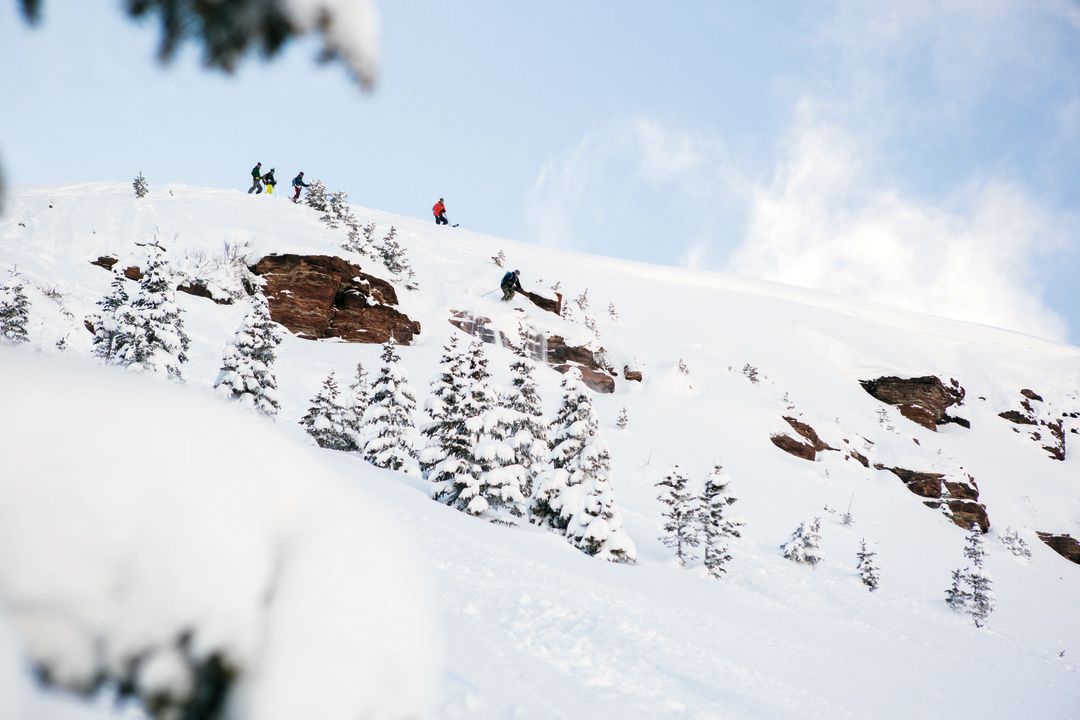
Image: Zach Mahone
Ever since then, locals have made East Vail part of their daily routine. Vail and Beaver Creek share a dozen “exit points” (Forest Service and resort officials prefer that term to “gates” ) where guests can leave the resort and enter public backcountry (read: uncontrolled and unpatrolled) terrain, but the one leading to East Vail is by far the most popular and delivers the steepest terrain—pitches in excess of 40 degrees. (Most avalanches happen on slope angles between 30 and 45 degrees.) People often reference the towering tubes that you see from I-70 and call the entire area the “East Vail Chutes,” but it is much more vast than just the prominent avalanche paths. There are dozens of lines to choose from; each has a name, and many carry foreboding acronyms—CDC stands for Charlie’s Death Chute, for instance.
Despite the explosion in use—estimates on busy days range from 200 to 300 skiers and snowboarders—and an increase in the number of people who carry avalanche rescue gear and know how to use it, experts believe the formidability of East Vail remains underestimated. “A lot of people go out there thinking it’s not as dangerous as above tree line, and they’re lulled into some sense of complacency because it is so close to civilization,” says Colorado Avalanche Information Center forecaster Scott Toepfer, who has investigated nearly a dozen accidents in East Vail during his 22 years on staff. “You ride right down to a bus stop, and the interstate’s directly below you.”
Steve Zuckerman, a paramedic and longtime Beaver Creek ski patroller and former Vail Mountain Rescue Group volunteer, adds: “Every winter I hear people say they’re safer in East Vail because it’s adjacent to the ski area. Or because it gets so much skier compaction, it somehow is less likely to slide than if you were in the Gore Range or on Vail Pass. People say that all the time—even locals. There is probably some truth to that, but I just tell them even a couple hundred people skiing out there in a week is not enough to mitigate the hazard.”
On the other hand, despite the number of close calls and fatalities over the years—seven people have died in East Vail avalanches in 24 years—when considered in conjunction with the area’s popularity, the number of people who actually get into trouble there represents a tiny fraction of all users. It isn’t a black hole for free spirits, no matter what its reputation might suggest.
“I think a lot of people don’t realize that there are times when it’s relatively safe; it’s just unbelievable skiing,” says Billy Mattison, a Vail ski patroller for 27 years who lives in East Vail and often skis home via the chutes after his shift. Many locals consider Mattison the resident expert on East Vail’s snowpack, but he has been hardened by its realities, too. “I’ve done a few body recoveries out there, and you never, ever forget those,” he says. “Digging someone out of the snow, and you look at him and realize that he was just like you that morning, eating breakfast and psyched to go out with his buddies—and now he’s dead. That sticks with you.
“But,” he adds after a pause, “the good memories far outweigh the bad ones.”
Maybe that’s the problem, if chasing good memories can be a problem. It has never been a problem for Jeremy Aschenbach, 39, who works as a night bellman at a local lodge and has skied East Vail as much as, if not more than, anyone since he moved to town in 1996. (His record is five laps in a day, with pro skier Seth Morrison.)
I met Aschenbach for a couple of East Vail runs on a chilly morning one April. He looked younger than he is, with blond stubble and squinted eyes tempered with an edge of gravitas. He didn’t say much as we rode the chair, but gradually he opened up about the impact the zone has had on his life, both good and bad.
On many days, the snowpack is so touchy there are only a few safe ways down, he said: “I’ve sneezed on faces and set them off.” Other days, just when you expect it to unleash its fury, it holds firm. “I’ve seen people undercutting huge cornices and getting away with murder,” he explained.
In 2008, Aschenbach himself triggered an avalanche on the West Wall and was thrown over a cliff as both his skis ejected. “The whole thing fractured above me and all the way across,” he said. “I probably got carried 600 vertical feet.” His ski partner jumped from a 25-foot cliff onto the slide’s icy bed surface to reach him, partially buried by the debris. “Luckily his binding fit my boot,” Aschenbach said, “and we both skied out on one ski.”
Aschenbach happened upon Tony Seibert’s group moments after the deadly slide last January. He helped a survivor with a broken leg get down the mountain. It was his second brush with fatality in East Vail. In January 2008, on their way out for a lap through the area, Aschenbach rode the lift next to a friend, Matthew Gustafson, who died in an avalanche 20 minutes later.
As Aschenbach and I skied past the Mongolia Poma lift shack on our way to the exit point, the liftie took note of our backpacks, which carried rescue gear, food, and water and included AvaLungs that would help us breathe under the snow in the event we were buried in a slide. (Aschenbach’s pack also contained an airbag, which inflates much like an automobile’s and, once deployed, can help keep a skier on top of a moving avalanche.) “Be careful,” the liftie said. The avalanche hazard was lower that day than it typically is during the middle of winter, and Aschenbach had a treed line in mind, where the snow remained cold and dry despite the spring temps. We attached our climbing skins and proceeded to the top of Benchmark, a perfectly white dome that caps Mongolia and East Vail, then peered down into our run. The fresh snow gleamed in the morning light.
Aschenbach pointed out a few runs to our west before sliding into the line. He hopped off the cornice and slashed powder turns all the way down to the bench. I followed, astonished at how good the snow was. We stuck to the shaded aspects all the way down to Main Gore Drive in East Vail, where we clicked out of our bindings, shouldered our skis, and walked through a neighborhood of million-dollar homes to catch the bus back to Vail Village for a second lap.
Fifty minutes later, standing on top of Benchmark again, I asked Aschenbach why he keeps skiing here, given his own near miss and the fatal accidents he’d been close to.
“I love skiing powder,” he said. “That’s what it is. That’s all it is.”
The problem of people getting into trouble after leaving the ski area boundary is certainly not unique to Vail. It happens throughout Colorado and around the world. At Beaver Creek in late December 2014, two local teenagers exited the resort through the Larkspur Bowl exit point intending to snowboard an avalanche-prone area known as the Y Chutes. Traveling without rescue gear or any survival essentials other than cell phones, they got lost and rode into a different drainage where they became trapped—unable to move in four feet of powder. “I truly believe they thought they were going to die,” says Zuckerman, who was on duty that night as mission coordinator at Vail Mountain Rescue Group headquarters and calmly reassured the boy who had called—and his sister—as five rescuers snowmobiled in three miles then skinned another half-mile to reach them.
Rescuers try to impart a message in cases like these (when exiting into the backcountry, be prepared to navigate through avalanche terrain and potentially spend a night outside if something goes wrong), but they realize that there is no way to reach everyone—and that those they do reach may not listen. All out-of-bounds rescues in the valley—typically a dozen or more each ski season—fall to VMRG volunteers (who do not charge for rescues for fear that the specter of a bill might deter backcountry users who truly need help from calling until it’s too late). Ski patrollers also respond to emergencies just outside resort boundaries if they are in a position to help, including in East Vail (Vail patrollers rallied en masse to the avalanche that killed Tony Seibert); however, they are not obligated to do so. As Vail Mountain executive vice president and chief operating officer Chris Jarnot describes it, lift-accessed backcountry terrain can be a vexing challenge for the resort.
“We don’t consider East Vail to be important to our business or the guest experience at Vail,” Jarnot says. “We would be perfectly happy if the Forest Service decided to either close access to it from the resort, or put it in the ski area and let us manage it. We would rather not have access to it from Vail Mountain. But the Forest Service and the public feel differently. So we wind up getting pulled into the implications of it being accessible from Vail Mountain and responding when there are issues.”
Other resorts have incorporated heavily trafficked, consequential backcountry terrain, notably Highland Bowl at Aspen Highlands and Peak 7 at Breckenridge. But while Vail Resorts once had the opportunity to include East Vail in its special-use permit boundary, it opted not to. And Jarnot doesn’t anticipate trying to add it anytime soon.
Instead, Vail installed new signs at its exit points this winter, intended to educate and reinforce the cold reality of backcountry skiing among those who cross the threshold. The most visible sign at East Vail, now an actual hinged gate you need to pull open, or duck under, to proceed, reads in block letters: WARNING. YOU ARE LEAVING THE SKI RESORT. YOU CAN DIE. THIS IS YOUR DECISION POINT. A skull and crossbones serves as punctuation.
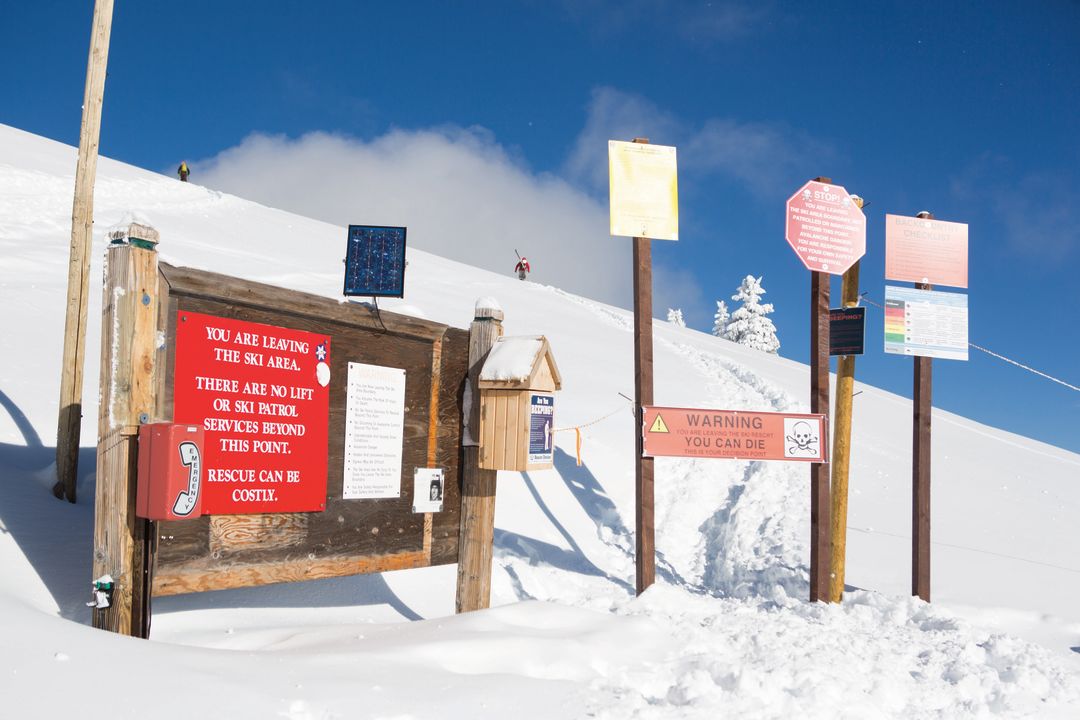
Image: Zach Mahone
The purpose is to leave no doubt in the guest’s mind about what he or she is doing. “You’re on your own,” Jarnot says. “Take that seriously.” Although most disagree with Vail’s desire to close access (of the 20 people I interviewed, the only contrarian opinion came from Denver attorney and longtime Vail skier Jim Aronstein, who worried that teenagers can’t comprehend the consequences of leaving the resort and entering uncontrolled terrain), all agree that as long as the boundaries are open, ultimately it is up to the user to accept responsibility and prepare accordingly.
Is that realistic? History says maybe. The plain fact is that we may never arrive at a time and place where each skier or snowboarder who leaves the resort’s backcountry exit points takes every recommended precaution and fully understands the consequences of his or her actions—as they relate both to themselves and to others, be they loved ones or rescuers. Even if that were to happen, as long as people venture into wild winter environments, the unpredictability of snow dictates that accidents will continue to occur—albeit hopefully at a lower rate than they have been transpiring recently.
“Really the only way you can make public lands perfectly safe for everyone is to not let people access them at all,” says USFS Eagle/Holy Cross district ranger Dave Neely. “That is directly contrary to our mission, which is to manage these lands for the use and enjoyment of the American people.
“The line between having a wonderful and rewarding experience in East Vail versus having the worst day possible is very fine, and it’s very difficult to know where that line exists at any given moment. But area closures are the last resort.”
We all should have the freedom to make our own decisions when we’re on Forest Service land outside of ski area boundaries,” echoes Pete Seibert Jr., nearly a year after his son’s fatality last winter. “After all, it’s our land.”
Seibert hopes the resort his father helped found someday expands into the zone where Tony died, to “add a dimension of skiing that Vail lacks.” If Vail were in Europe, he believes everything would be lift served already.
Since Tony’s accident, East Vail has taken on new meaning to the Seiberts. Last summer, “Circle” (as Pete Jr.’s known) and various members of his family, as well as two of Tony’s friends, hiked up to the site of the accident and retrieved one of Tony’s melted-out skis and GoPro, found six feet apart, nestled in the grass. “I think we’ll make that hike at least once a year,” Seibert says. “It’s a beautiful place, and it feels good to be there and to remember Tony.”
It helped that the snow that had buried his son had been replaced by flowering green. But when the powder came back, in November, then deepened during a series of storms in December, the cycle started anew. Hundreds of skiers flocked to East Vail, chasing good memories.
The Seiberts were not among them. “We are dealing with a terrible tragedy, and I don’t think any of us wants to add to that pain,” Pete Jr. said in mid-December.
But, he added, “There may well be a day when we all decide to ski it together.”
